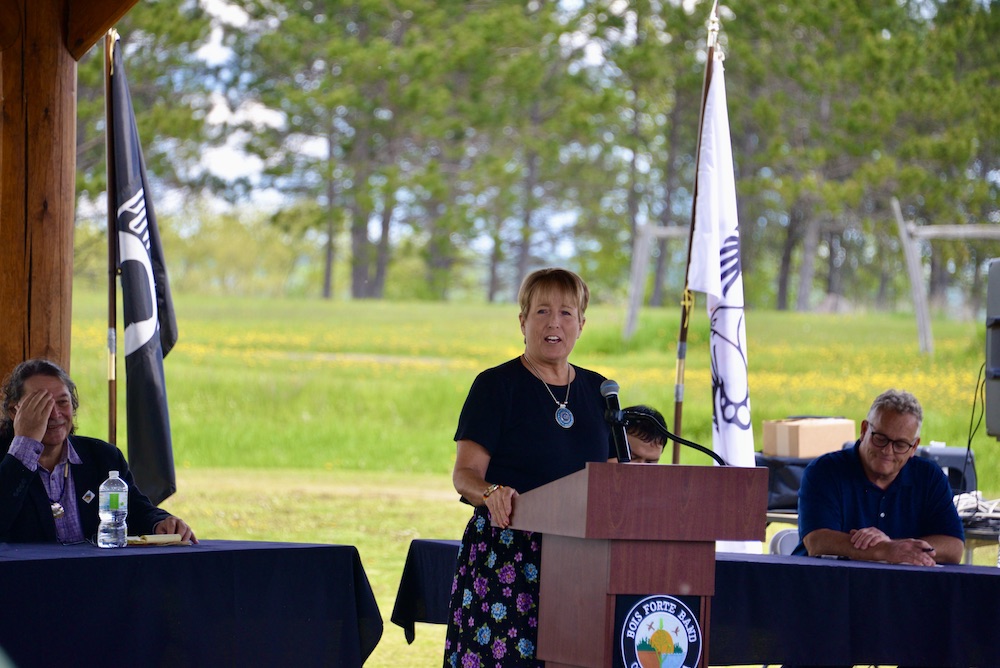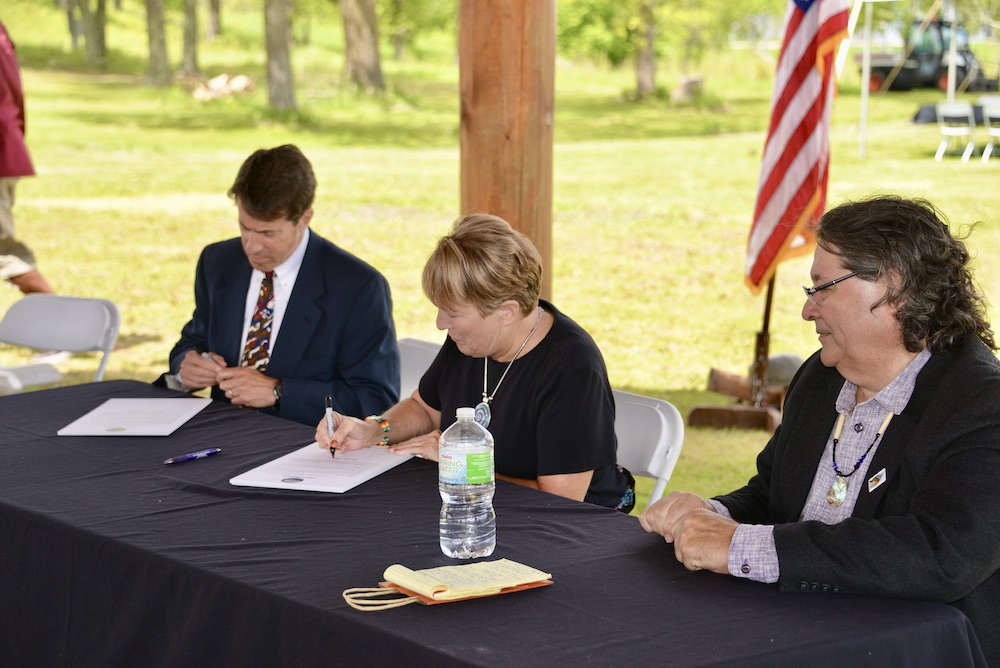
- Details
- By Jenna Kunze
In the largest land-back agreement in Minnesota and one of the largest-ever in Indian Country, the Bois Forte Band of the Minnesota Chippewa Tribe today restored more than 28,000 acres of land within its reservation boundaries back to tribal ownership.
The purchase of the 28,089 acres in northern Minnesota from The Conservation Fund will restore lands that were sold by the federal government to non-Natives as “surplus” under the Allotment Act, which attempted to break up tribal reservations.
“So when we hear about reservations today, a lot of that land is not our land,” Cathy Chavers, chairwoman of The Bois Forte Band of the Minnesota Chippewa Tribe, said during a live streamed announcement today at Nett Lake, Minn.
Chavers described the Bois Forte reservation as a “checkerboard” that sits roughly 45 miles south of the Canadian border. The “checkerboard” reservation is divided into three sectors: Nett Lake, Vermilion, and Deer Creek. The 28,000 acres will be restored in the Nett Lake and Deer Creek sections of the reservation.
Bois Forte Band tribal member Kristen Lilya, who also works as a marketing specialist for Native News Online, said that, growing up, she thought her tribe’s land began and ended at the reservation line.
“As I grew older, I realized how checker-boarded (it is) is actually due to Allotment,” Lilya said. “I am glad that this land is coming back to our reservation today because it will be used for generations to come.”
The Bois Forte Band plans to directly manage the restored lands under a forest management plan that emphasizes conservation and environmental protection, balanced with economic and cultural benefits to the Band and its members, according to a statement.
The purchase was financed by the Indian Land Capital Company (ILCC), a certified Native Community Development Financial Institution that is owned by the Indian Land Tenure Foundation, a national, community-based organization serving tribal nations and people in the recovery and control of their homelands.
"ILCC is proud to provide the financing to make this transaction possible," CEO Rjay Brunkow told Native News Online. "It represents one of the larger transactions in company history and we are proud and honored to provide the financing to make this historic land acquisition happen. We are especially happy to partner with the Bois Forte Tribe in this massive expansion of the tribe's land base."
Bois Forte Chairwoman Chavers said that today is historic not just for the Bois Forte Band, but for Indian Country.
“Today we are acquiring—not through legislative action—over 28,000 acres of land that our tribe of 3,500 members does not have to pay a dime for.”
“I really want to say that because this is the largest restoration in the state of Minnesota and in the country, ever, that we are making history,” Chavers said. “We are proud to be here today to bring this back to our people, and our ancestors are looking down upon us and they are very happy because land is coming back.”

Leaders from The Conservation Fund and the Indian Land Tenure Foundation hailed the agreement.
“This outcome honors the heritage of this land by reuniting it with the Bois Forte Band and ensuring its long-term stewardship,” Larry Selzer, The Conservation Fund’s president and CEO, said in a statement. “We respect the Band as the best possible caretakers for this forestland and celebrate together this historic milestone.”
Cris Stainbrook, president of the Indian Land Tenure Foundation, called the announcement a "meaningful step" that he hopes inspires other land-back activities throughout Indian Country.
"As we work to ensure more Indian lands return to Indian hands, today’s announcement demonstrates a meaningful step on the long journey ahead,” Stainbrook said in a statement. “We are proud to have helped the Bois Forte Band reach this milestone moment and hope that it inspires many more like it throughout Indian Country. And, it reminds all of us that restoring land to Indian ownership, management and control is more than a hashtag, it is a reality.”
The return of the land to the Bois Forte Tribe is the latest land-back agreement in the state of Minnesota over the past two years. Last month, the Associated Press reported that the federal government would return 12,000 acres of Minnesota land it had wrongfully taken from the Leech Lake Band of Ojibwe. In February 2021, the Minnesota Historical Society transferred approximately 115 acres of land back to the ownership of the Lower Sioux Indian Community.
With news coverage of each land back agreement comes an opportunity to educate the general public about how the federal government and other organizations took the land from tribes. Bois Forte Chairwoman Chavers said the tribe is pushing for true Native history to be taught in Minnesota schools.
“We've heard about the boarding school issues, and those have really come to light,” she said “But not a lot has not been told of our history of our land that was taken from us.
“I know that our tribal leaders today and a lot of educators are working to get our Native American history taught in our schools so people understand what significance and importance this day has for Bois Forte.”
Editor's Note: This story has been updated to clarify the financing of the project and to add a quote from Indian Land Capital Company.
More Stories Like This
50 Years of Self-Determination: How a Landmark Act Empowered Tribal Sovereignty and Transformed Federal-Tribal RelationsCherokee Nation Launches Digital Dictionary to Support Language Revitalization
Prairie Band Potawatomi Nation Chairman Addresses Homeland Security Contract
Lancaster County to Recognize Conestoga-Susquehannock Tribe on Massacre Anniversary
How the Gaming Economy Helps Tribes Navigate Shifting Policies
Help us defend tribal sovereignty.
At Native News Online, our mission is rooted in telling the stories that strengthen sovereignty and uplift Indigenous voices — not just at year’s end, but every single day.
Because of your generosity last year, we were able to keep our reporters on the ground in tribal communities, at national gatherings and in the halls of Congress — covering the issues that matter most to Indian Country: sovereignty, culture, education, health and economic opportunity.
That support sustained us through a tough year in 2025. Now, as we look to the year ahead, we need your help right now to ensure warrior journalism remains strong — reporting that defends tribal sovereignty, amplifies Native truth, and holds power accountable.
 The stakes couldn't be higher. Your support keeps Native voices heard, Native stories told and Native sovereignty defended.
The stakes couldn't be higher. Your support keeps Native voices heard, Native stories told and Native sovereignty defended.
Stand with Warrior Journalism today.
Levi Rickert (Potawatomi), Editor & Publisher


